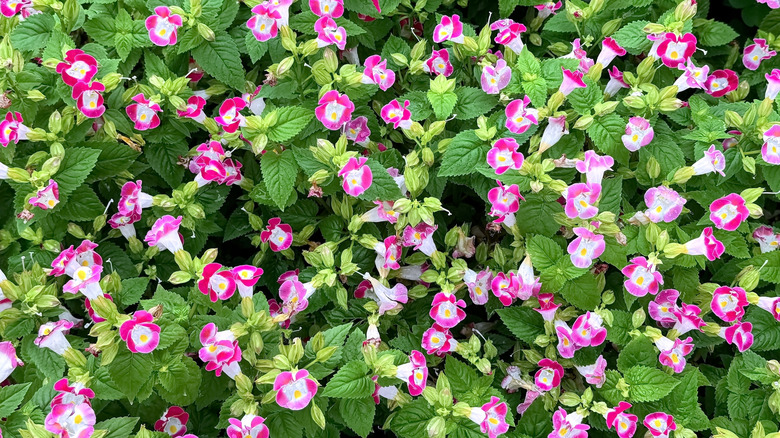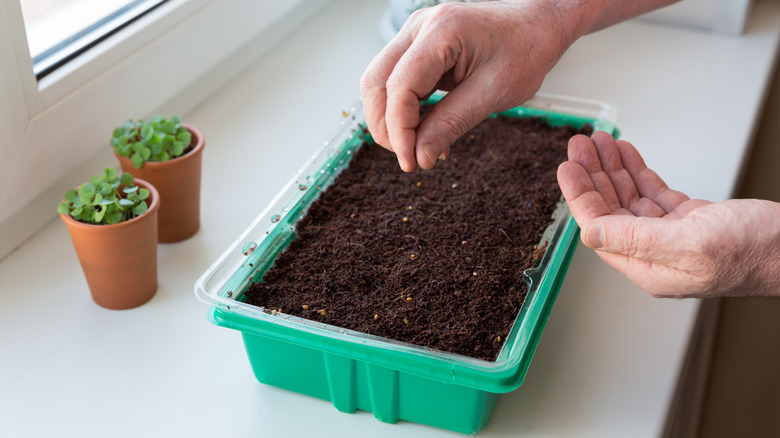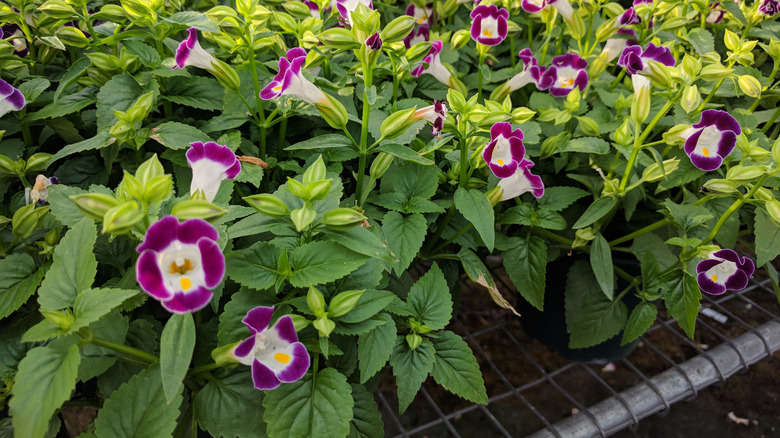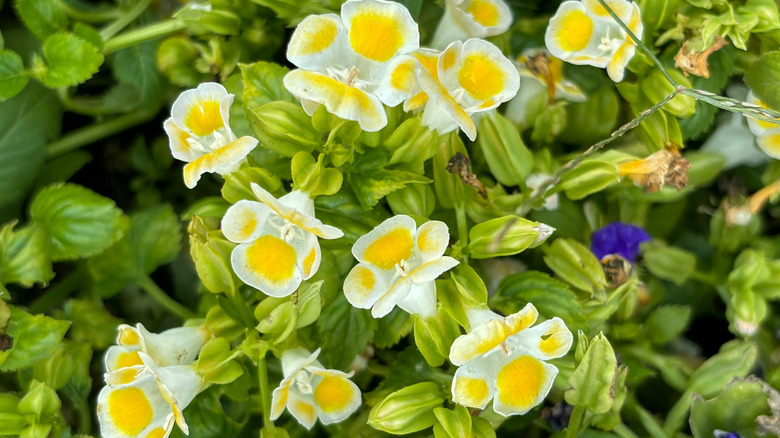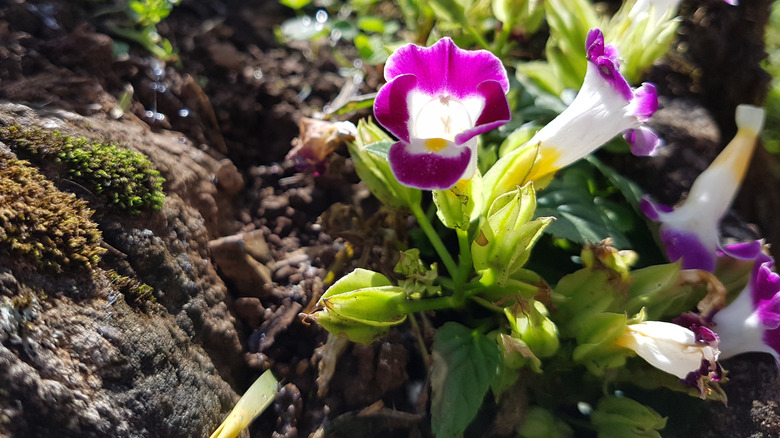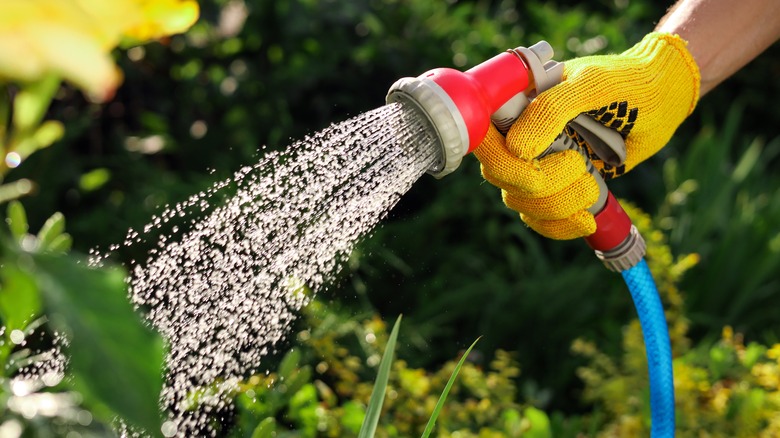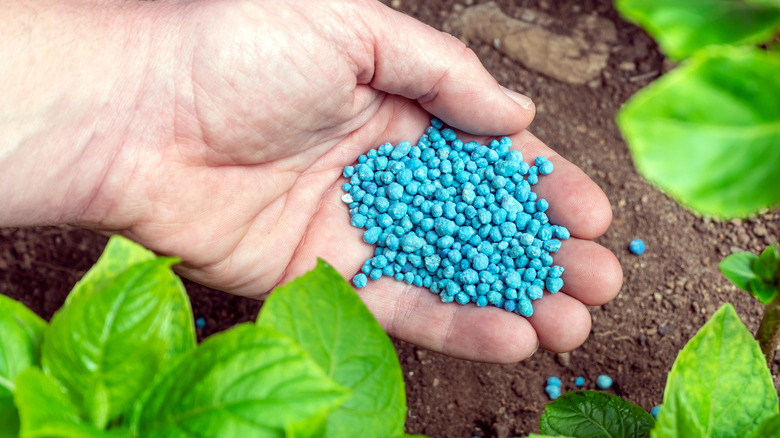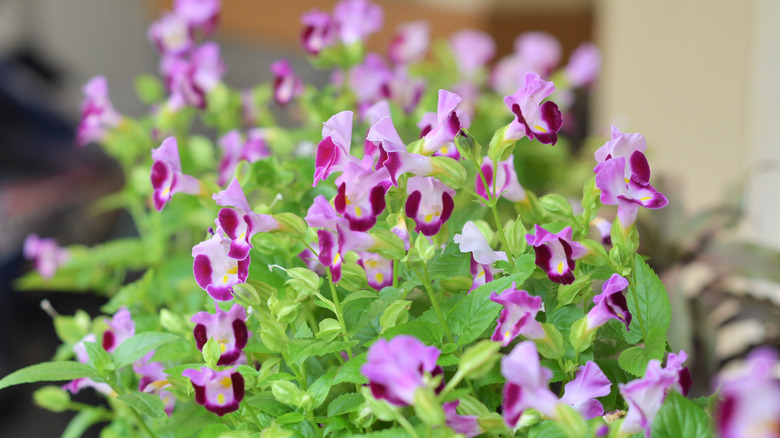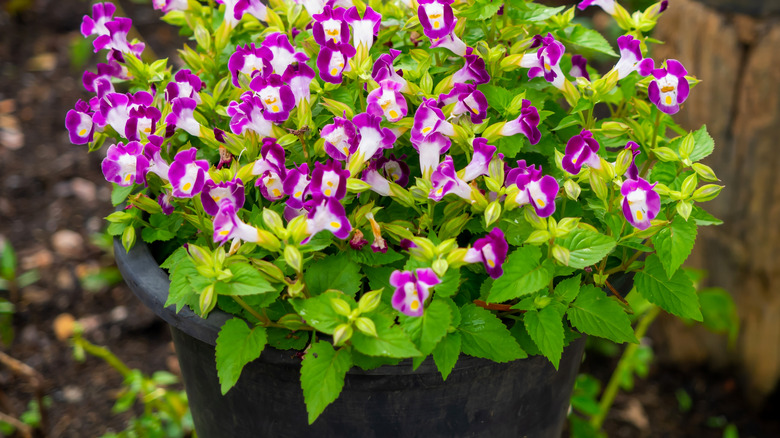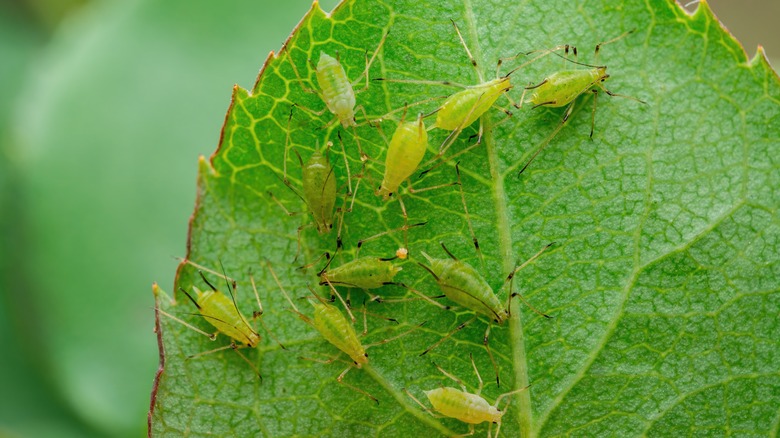How To Grow And Care For Beautiful Wishbone Flowers
We may receive a commission on purchases made from links.
Wishbone flowers (Torenia fournieri) are beautiful spring annuals that will turn your garden into a colorful showstopper. These trumpet-shaped beauties feature velvety petals that often have a striking contrast of colors with a yellow spot on the throat. Aptly named, their two stamens join together at the top to create a unique, wishbone-like shape. Although they're typically a two-toned lilac-purple, there are several cultivars available that come in shades of white, yellow, blue, violet, and pink. Their vibrant blooms and fragrant leaves will grace your garden until the first frost, long after many other species have faded. Native to Asia, they flourish in warm, humid climates, though they can thrive in hardiness zones 2 through 11 with the proper care.
These charming plants are low-growing and bushy, only reaching about 6 to 12 inches tall, making them perfect for edging and borders. Wishbone flowers also have a trailing habit that looks beautiful in containers like window boxes. Adding these two-toned flowers to hanging baskets is sure to attract hummingbirds, as their tubular shape allows the birds to easily insert their beaks to drink nectar. However, no matter where you place these showy plants, the area is sure to be buzzing with pollinators. Perfect for informal or cottage gardens, their shade tolerance comes in handy for brightening up areas where other flowers struggle to thrive. If you want to incorporate wishbone flowers in your yard, here's everything you need to know about how to grow and care for them.
Growing wishbone flowers from seed
Although it might feel daunting to grow flowers from seed, it can be more cost-effective than purchasing young plants from a nursery. Additionally, with so many cultivar series available online, you can choose several varieties for even more color combinations. The only downside is that the seeds are incredibly small, and not all of them may germinate, making them a bit challenging to work with. Start them indoors 8 to 12 weeks before the expected last spring frost date to give them a head start before planting outside.
Add a slightly moist, organic, well-draining seed-starting mix to starter pots or trays. Rather than burying them, use your thumb to gently press 2 to 3 seeds into the dirt and mist them with a spray bottle to help them settle into the soil. To increase humidity, you can set a clear plastic lid over the top. Place them near a window that receives bright, indirect sunlight and keep the temperature of the room between 70 and 75 degrees Fahrenheit. They're sensitive to dry conditions, so keep the soil consistently moist as they grow. After a few weeks, when they develop a few true leaves, remove the smaller seedlings, leaving behind only one strong wishbone flower plant per pot. After the final frost, take a week to harden off the plants by setting them outside for a few hours each day to allow them to adapt to the elements gradually. Space the seedlings about 12 inches apart when planting to allow plenty of room for them to spread.
Growing wishbone flowers from the nursery
If you want to avoid the challenges that come with starting flowers from seed, you can often find established wishbone flowers at nurseries or garden centers. Although it can be rewarding to watch your little seeds transform into beautiful flowers, there's no denying how exciting it is to fill your garden with color instantly. Plants grown in a nursery are already acclimated to the local conditions and are typically well-rooted and ready to either be planted out or potted up. To make sure you're only choosing the healthiest plants when buying from a nursery, thoroughly inspect each plant for signs of pests and diseases.
Although young wishbone flowers have a little more experience with outdoor elements than indoor-grown seedlings, it's still a good idea to harden them off. Depending on where you plant them, they may experience more or less sun, wind, and other conditions than at the nursery. Once they're ready, choose a spot with well-draining soil to prevent waterlogging, and amend with organic matter if needed. Dig a small hole the same size or slightly larger than the nursery pot. Gently remove the wishbone flowers from their container and place them into the soil. Space the plants about 12 inches apart to promote proper air circulation, as placing them too closely together can lead to issues like powdery mildew.
Plant wishbone flowers in a shady spot in your garden
Wishbone flowers aren't just plants that can tolerate shade, but actually thrive in shady conditions. Unlike sun-loving species, these pretty blooms do best when they're shielded from direct sunlight, which can scorch their delicate petals and leaves. However, you don't want to plant them in an area where they go all day without seeing some sun. One sign your wishbone flowers could use a bit more light is if they have a decrease in blooming. They need at least two hours of sunlight each day, ideally early morning sun with shady protection from the harsh rays that emerge in the afternoon. Partial shade, like dappled sun filtering through the trees, provides the perfect amount of light for them to thrive.
You can easily grow a flourishing shade garden by pairing them with other shade-tolerant plants. Hostas and ferns provide some textual contrast against Torenia's lance-shaped leaves. To brighten up the shady areas with more color, plant other shade-loving flowering annuals like impatiens or lobelias. Because wax begonias have similar care conditions, they're another option that will thrive alongside your wishbone flowers.
Grow wishbone flowers in soil that's rich in organic matter
Choosing the right soil is one of the most critical aspects when caring for wishbone flowers. Although they thrive in consistently moist soil, they cannot withstand waterlogging. Well-draining blends are key, allowing the water to soak through to the roots without pooling up and getting their feet wet. Heavy, compacted soils that hold onto water can lead to a common Torenia issue: root rot. Additionally, soil rich in organic matter will provide wishbone flowers with vital nutrients that help them produce their best blooms. Although they aren't too picky about the pH level, they prefer slightly acidic to neutral soil.
Yellowing leaves, stunted growth, or sparse blooms are a few signs your wishbone flowers may need more organic matter added to the soil. If water pools around the base of your flowers after you water them or after recent rainfall, this indicates that the soil is holding onto moisture. On the other hand, if the soil is drying out quickly after watering, you may notice your plants start to wilt. Amend sandy soils with Canadian peat moss to improve moisture retention. Because Canadian peat moss is acidic, mixing this into the dirt can also help lower the pH. Another way to extend the time between waterings is to add a layer of mulch around your wishbone flowers to keep water from evaporating as quickly. To break up heavy soil, mixing in compost or aged manure will do the trick.
Water wishbone flowers regularly
There are a few mistakes to avoid when watering your garden, including how much water to use, how often you water, and the best time of day to do it. Wishbone flowers have average watering needs, meaning they don't like their soil to dry out completely between drinks. Stick a finger into the top inch or so of soil to get an idea of what the moisture levels are. Ideally, you should water your wishbone flowers when the top layer of soil feels almost dry. You should use the same finger test for Torenias growing in containers, though they'll likely need watering more often than bed flowers.
Because overwatering can lead to root rot, it may seem logical to avoid saturating the soil during your watering sessions. However, by doing so, you may ironically be underwatering your flowers instead. To properly water wishbone flowers, make sure you fully saturate the soil so the water can make its way down to the roots. Aim the hose underneath the foliage and flowers, only getting the dirt wet. If droplets sit for long periods of time on the leaves or petals, they are more likely to foster disease-causing mildew and fungi growth. The best time of day to water your plants is in the morning to allow excess moisture to dry out throughout the day.
Promote wishbone flower blooms with fertilizer
Even if you have the best soil blend and a watering schedule down, your Torenias may struggle to bloom if they aren't fed regularly. Fertilizers are like vitamins for plants, providing essential nutrients like nitrogen, phosphorus, and potassium necessary for growth and flowering. Because potted plants have a limited supply of nutrients, wishbone flowers growing in containers may need to be fed more often than those placed in a garden bed. If your Torenias aren't growing as fast as they should be, aren't blooming, or have an overall dull look, it's a good sign they're ready to be fertilized.
Read any instructions before applying fertilizer to your plants. Typically, you'll want to give your wishbone flowers a boost at the beginning of the growing season by applying a slow-release fertilizer after planting. Help make sure the nutrients reach the roots by watering before you add the granules. Moving forward, you can apply the same slow-release fertilizer or opt for a liquid fertilizer every few weeks during the blooming season. Generally, container plants do well with a water-soluble feed every few weeks as well. If you notice any signs of decline after feeding, like brown or yellow leaf edges, it may signify that your wishbone flowers are over-fertilized. Give them some extra time to bounce back, and hold off on the plant food for a bit longer than usual.
Winter care for wishbone flowers
As annuals, wishbone flowers cannot withstand frost and will die off during the winter. Because these showy flowers won't return the next year if left outside, you're only left with a few options. One is to leave them outside and let them complete their natural cycle and start fresh with new Torenias the following season. Alternatively, if you have potted wishbone flowers, you can bring them indoors over the winter. If you want to avoid digging your flowers out from a bed, but don't want to lose them to the cold, you can propagate them with stem cuttings.
To grow a new wishbone plant from cuttings, use a sharp, clean pair of scissors to remove a few stems containing nodes on a mature plant. Remove the bottom leaves and place the stems in a small container with water. Once roots develop, plant the cuttings in compost or potting soil. Alternatively, you can try rooting your cuttings directly in soil with the help of some softwood rooting hormone compound, such as the Hormex Rooting Hormone for Cuttings. Whether you're growing propagated wishbone flowers or relocating your potted plant inside, place them near a window where they'll receive bright, indirect light. Container Torenias will likely need less water during winter than during the growing season. However, you should continue with the finger test and water when the soil starts to dry out.
Repotting wishbone flowers
As your wishbone flowers grow, they'll need more room to stretch their legs. Because there's limited space as roots become crowded, they'll struggle to absorb nutrients from the soil. When your wishbone flowers are ready to upgrade to a new pot, stunted growth may be the first visible clue. That said, it's a good idea to get into the habit of checking the roots annually to determine if it's time to repot or not. If they're tightly wound around the inside of the pot or are growing out of the drainage holes, it's time to give your plant a new home.
When repotting Torenias, choose a new container with drainage holes that's an inch or two bigger than the previous pot. If plastic, gently squeeze the sides of the pot to help loosen the soil. It can help to insert a hand trowel or small gardening tool in between the dirt and the plastic to help ease the plant out. Once you remove your wishbone flowers from the old container, gently massage the root ball to untangle the roots and release excess soil. Add a layer of fresh soil to the bottom of the new pot and set the rootball inside, making sure there's about half an inch of space between where the soil line will be and the rim. Finish filling the pot with fresh soil and give it a good watering.
Common wishbone flower pests and diseases
Although wishbone flowers aren't prone to any serious pests or diseases, it doesn't mean it can't happen. The most common unwelcome visitors that may feed on Torenias are aphids and whiteflies, which damage leaves by sucking their sap. Leaf curling, yellowing, or stunted growth are signs one or both of these insects are taking over your plant. Wishbone flowers may also be affected by diseases like root rot and powdery mildew in unideal conditions. Overly wet soil from overwatering or compact soil leads to root rot, causing mushy roots, yellowing leaves, and plant wilting. Poor circulation can lead to powdery mildew, which appears as a white, powdery coating on the leaves and stems and can weaken the plant over time.
Inspect your plants regularly and look for signs of pests or disease. To manage aphids and whiteflies, a strong jet of water is usually enough to knock them off. If your plants can't take a strong stream of water, you can also try and shake off the insects into a bucket. Neem oil is a natural insecticide that can eliminate larger infestations, thanks to the active ingredient azadirachtin. Prevent root rot by watering when the top inch of soil is dry, amending compact soils with organic matter, and not adding more than a 3-inch layer of mulch. To keep powdery mildew from developing, avoid overhead watering and make sure your plants are always adequately spaced with good air circulation. Treat your wishbone flowers with a fungicide if you notice any signs of powdery mildew.
